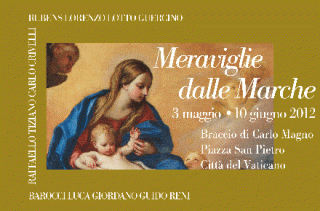What does a museum do when it closes for renovations? If it's the Pinacoteca Comunale of Ancona in Le Marche, it takes the show on the road--along with the other most striking and well-known works from the region.
Through the 10th of June, the "Meraviglie dalle Marche" (Marvels from the Marche) exhibit in the Braccio Carlo Magno hall in St. Peter's Square in Vatican City unites 50 paintings from museums in Urbino, Ancona, Ascoli Piceno, and other towns around Le Marche under one roof. As the pieces come from 15 cities, they would usually take more than a week to visit in their original locations.
Curated by Costanza Costanzi, Giovanni Morello, and Stefano Papetti, the exhibit incorporates art from the end of the 14th century to the beginning of the 19th century in a chronological and thematic circuit. From the Virgin Mary room with Guido Reni's "Annunciation" and Crivelli's vivid yet delicate "Madonna with Child" the exhibit moves to the Christ room featuring Tiziano's "Christ Risorto" (Christ Risen).
The saints room highlights some of the region's best known works, including Guido Reni's "Saint Sebastian", which has become an important symbol of the gay community for its depiction of grace in suffering, and the only Raphael in the exhibit. The "Saint Catherine of Alexandra", a smaller version of the one in the National Gallery in Washington, D.C., by Le Marche's most famous artistic son is thought to have been part of a triptych and was painted by the artist when he was just 18 years old.
Several Venetian painters who spent their lives in Le Marche, including Carlo Crivelli, Paolo Veneziano, and Lorenzo Lotto--Tiziano's rival--are also featured, as well as Rubens, who lived in the region. The exhibit also highlights some lesser-known but gifted, regional artists, such as Andrea Lilli, Francesco Podesti, and Rafael's father Giovanni Santi.
After its showing in Rome, the exhibit will move onto Buenos Aires, to honour the over 40 per cent of Le Marche emigrants who moved to Argentina.










